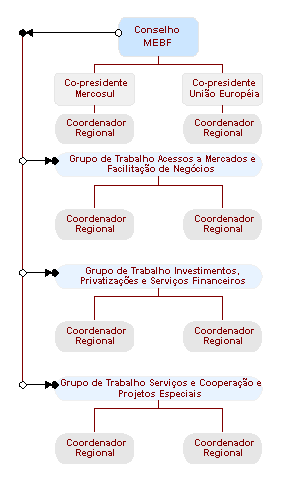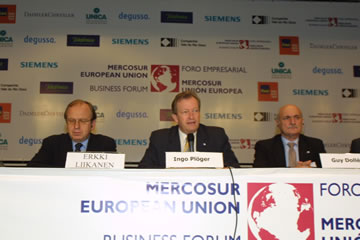Mercosur and
European Union
History MEBF – Mercosur European Business Forum

The MEBF with its conferences, as of 2003 in Brasília (Brazil), participated more than 350 companies and important associations in the market which was chaired/organized by Ingo Plöger, co-chairman Mercosul, and by Guy Dollé, co-chairman European Union.
Since its first plenary, the MEBF has received the attention of important political and business representatives, as well as several ministers of economy from countries of the European Union and Mercosur. All Plenary Conferences were marked by final documents that contributed to official agreements between the regions. This edition was no different..
The forum received senior members of the Council and the European Parliament, the European Commission and the governments of the countries participating in Mercosur. Among them were: the President of Brazil, Luís Inácio Lula da Silva, the President of the Government of Spain, José María Aznar, the Minister of Interior Affairs of Argentina, Aníbal Fernández, Carlos Lessa, President of BNDES, Márcio Fortes, Interim Minister of Ministry of Development, Industry and Trade, Celso Amorim, minister of the Ministry of Foreign Affairs, Alberto Navarro, European Commission ambassador to Brazil, Roberto Abdenur, Brazilian ambassador to Austria, and European commissioners Erkki Liikanen and Karl Falkenberg. The conference ended with the signing of the Brasilia Declaration, which included dozens of joint recommendations from representatives of companies, business associations and organizations from Mercosur and the European Union.

The proposals – in the short, medium and long term – refer to access to markets, investments and services, and are delivered to government authorities in both regions. Among the main points discussed are:
– notably, agriculture is the most critical issue in the relations between the two blocs. Limited access to the European market and subsidies to the agricultural sector restrict Mercosur’s possibilities for exports of agro-industrial products.
– Free trade negotiations between Mercosur and the EU must provide for asymmetric reciprocity in tariff reduction, as occurred in the agreements with Mexico and South Africa.
– expressions of intention to consolidate and deepen the Customs Union must be carried out.
– MEBF request that governments formally respond to the recommendations presented in the Declaration of Madrid, of May 2002, which contains consensus suggestions to deal with issues that remain critical in the negotiations such as rules of origin, special and differential treatment, trade defense, admission goods, and nascent industry. MEBF hopes to obtain these answers during the next meeting of the Bi-Regional Negotiations Committee.
– MEBF presents, in the Brasilia Declaration, new measures to facilitate business in the Brasilia Declaration. They cover the area of customs procedures, with concrete proposals to speed up the clearance of goods and also incorporate a new area that is very important for bi-regional relations, which is direct investments. Measures to simplify administrative procedures for short-term investments are presented. A Conference to propose a plan of action in this area should be organized soon.
– businessmen asked Mercosur to present its offer for the liberalization of government purchases, since the European Union has already presented its offer.
– in the area of services, the MEBF suggests to the negotiators that they define the coverage of the agreement, which must be comprehensive and include the treatment of audiovisual services and maritime and air transport.
– The important opportunities that exist for projects in the area of “Clean Development Mechanisms”, which involve carbon emission credits under development in Mercosur in the area of renewable resources and reforestation, should be better used.
For businessmen involved in discussions of biregional agreements, the results are extremely positive and should influence the Mercosur and European Union negotiations, held in November in Brussels.
Mercosur
Mercosur, springboard for development
The Argentine Republic, the Federative Republic of Brazil, the Republic of Paraguay and the Oriental Republic of Uruguay signed the Treaty of Asunción on March 26, 1991, creating the Southern Common Market, MERCOSUR, which constitutes the most relevant international project with the which these countries are committed to.
More than 10 years after the signing of this treaty, MERCOSUR today represents an economically viable and politically stable regional grouping that has been able to take advantage of the lessons and opportunities of globalization and, thus, increasingly attract the interest of the whole world.
The four MERCOSUR countries share their efforts to consolidate democracy, legal security, the fight against poverty and economic and social development with equity. For this reason, the agreement is above all a springboard for the development of the region as a whole and expansion of the dimensions of the respective national markets through integration.
The primary focus of this initiative is linked to the free circulation of goods, services and productive factors, the establishment of a common external tariff and the adoption of a common trade policy, the coordination of macroeconomic and sectoral policies and the harmonization of legislation in the relevant areas .
Three years after the Treaty of Asuncion, but a step was taken towards the realization of this project. In December 1994, at the President’s Summit in Ouro Preto, an Additional Protocol was approved – the Ouro Preto Protocol – which establishes the institutional structure of MERCOSUR, endowing it with international legal personality.
Starting in 1996, with the Presidential Declaration on Democratic Commitment in MERCOSUR and the Protocol of Accession of Bolivia and Chile, the common commercial policy advanced with the adoption of tools that govern the free trade zone and the customs union that characterize the MERCOSUR, headed by the Common External Tariff.
Politics
MERCOSUR represents the most important political agreement reached in the region. Its “political safety net” generates the rules of the game necessary for the existing economic and commercial interrelations to be fully developed. Furthermore, the deepening of economic and political ties allow for joint action, avoiding fragmentation in the South American region.
A new scenario
Created as a customs union, Mercosur promoted profound economic changes in the region: joint commitment of national trade policies; creation of a common external tariff; agreement for possible changes in the production levels of the productive sectors; strengthening of opening and insertion processes in world markets; inclusion of the region in a strategic international trade agenda; domestic and foreign investments.
One of the great virtues of MERCOSUR is that it managed to have the negotiation process carried out on realistic, reasonable and flexible bases for the realities of the four countries. The negotiations carried out over the last few months and the agreements reached highlight this assertion. All countries seek to defend their main interests and, at the same time, need to take into account the problems and realities of the other partners.
This allowed its member countries an arduous, transparent and solidary negotiation exercise that only brought development opportunities to all those involved. After all, Mercosur maintained an agenda particularly for trade negotiations with third countries or groups of countries, since the agreement itself is the result of a concept of an initiative open to the outside world.
For more information, visit the website: http://www.mercosur.int
European Union
European Union
Integration means common policies
Since the 1950s, Europe has been formulating ways to act together in the face of the growing complexity of the economic scenario. In the following years, there was a continuous creation of agreements and policies that resulted in greater cooperation between the countries of the continent.
Finally, in 1992, the Maastricht Treaty was signed by the member countries of the European Parliament (created in 1967) giving rise to the European Union (EU). Their economic and political integration has generated joint decisions on common policies in a very wide range of fields, from agriculture to culture, from consumption to competition, from the environment and energy to transport and trade.
At first, attention was focused on solutions that met the needs of sectors such as coal, steel and agriculture. Over the years, other aspects emerged as a result of changes in the world scenario, both in terms of economics and politics, as well as in terms of scientific and social development. For example, the objective of agricultural policy is no longer to produce as much food as economically possible, but to support farming methods that result in high-quality production and that protect the environment. In fact, the need to protect the environment is now considered in all EU policies.
Its relations with other countries have brought on the agenda international trade agreements, the development of a Common Foreign and Security Policy, as well as an aid fund for other countries.
The single market
Eliminating all obstacles to trade and converting the “common market” into something unique and authentic where goods, services, people and capital could move freely was not an easy task. The single market was formally completed at the end of 1992 although some issues such as the creation of a single market for financial services have not been fully achieved. During the 1990s it was easier for people to move across Europe, as passport and customs controls were lifted at most of the EU’s internal borders. One consequence was greater mobility for its citizens; since 1987, for example, more than 1 million young Europeans have been studying abroad with the support of the EU.
The single currency: the euro in your pocket
In 1992, the EU decided to embark on an economic and monetary union (EMU) that entailed the introduction of a single European currency managed by a European Central Bank. This currency (the euro) became a reality on January 1, 2002, when it replaced the national currencies in 12 of the 15 countries of the Union (Belgium, Germany, Greece, Spain, France, Ireland, Italy, Luxembourg, Netherlands, Austria, Portugal and Finland).
The family grows
Germany, Belgium, France, Italy, Luxembourg and the Netherlands were already part of the group interested in creating an economic bloc. But the family grew in size through successive waves of adhesions. Denmark, Ireland and the United Kingdom joined in 1973, followed by Greece in 1981, Spain and Portugal in 1986. After the formal creation of the European Union in 1992, Austria, Finland and Sweden joined in 1995.
The EU is now preparing to welcome another ten countries from Eastern and Southern Europe: Cyprus, Slovakia, Slovenia, Estonia, Hungary, Latvia, Lithuania, Malta, Poland and the Czech Republic, countries which are expected to join in 2004.
Bulgaria and Romania wait for a few years later and Turkey is also a candidate.
To ensure that the EU can continue to function effectively with 25 members or more, its decision-making system must be more fluid. That is why the Treaty of Nice, which entered into force on February 1, 2003, sets new rules on the size of EU institutions and their way of working.
Source of this text: former European Union website: http://europa.eu.int
See more:
LATEST PUBLICATIONS:
© Todos os direitos reservados - IPDES | by Next4.































